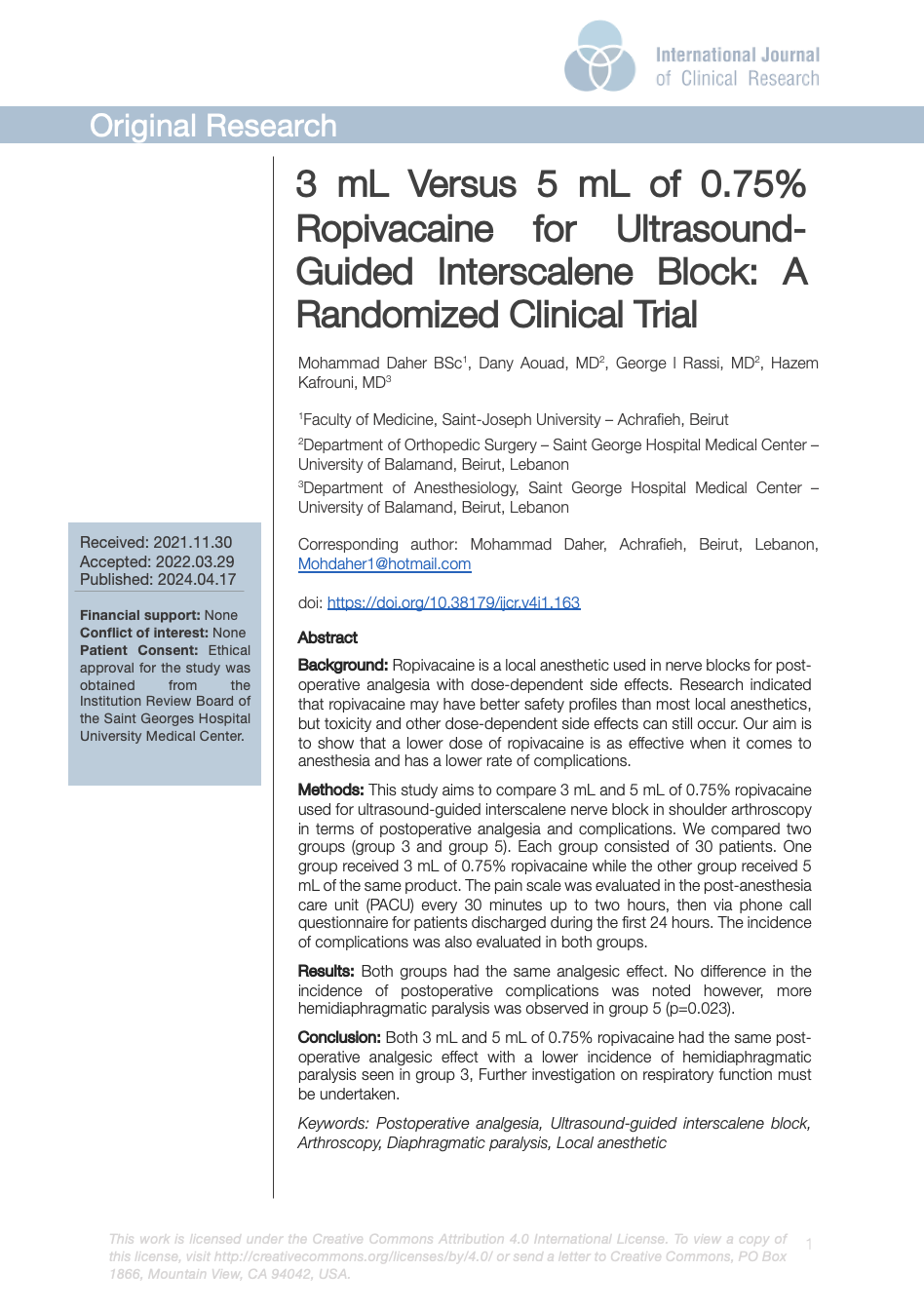3 mL Versus 5 mL of 0.75% Ropivacaine for Ultrasound-Guided Interscalene Block: A Randomized Clinical Trial
DOI:
https://doi.org/10.38179/ijcr.v4i1.163Keywords:
Postoperative analgesia, Ultrasound-guided interscalene block, Arthroscopy, Diaphragmatic paralysis, Local anestheticAbstract
Background: Ropivacaine is a local anesthetic used in nerve blocks for post-operative analgesia with dose-dependent side effects. Research indicated that ropivacaine may have better safety profiles than most local anesthetics, but toxicity and other dose-dependent side effects can still occur. Our aim is to show that a lower dose of ropivacaine is as effective when it comes to anesthesia and has a lower rate of complications.
Methods: This study aims to compare 3 mL and 5 mL of 0.75% ropivacaine used for ultrasound-guided interscalene nerve block in shoulder arthroscopy in terms of postoperative analgesia and complications. We compared two groups (group 3 and group 5). Each group consisted of 30 patients. One group received 3 mL of 0.75% ropivacaine while the other group received 5 mL of the same product. The pain scale was evaluated in the post-anesthesia care unit (PACU) every 30 minutes up to two hours, then via phone call questionnaire for patients discharged during the first 24 hours. The incidence of complications was also evaluated in both groups.
Results: Both groups had the same analgesic effect. No difference in the incidence of postoperative complications was noted however, more hemidiaphragmatic paralysis was observed in group 5 (p=0.023).
Conclusion: Both 3 mL and 5 mL of 0.75% ropivacaine had the same post-operative analgesic effect with a lower incidence of hemidiaphragmatic paralysis seen in group 3, Further investigation on respiratory function must be undertaken.
References
Hartrick CT, Tang YS, Siwek D, Murray R, Hunstad D, Smith G. The effect of initial local anesthetic dose with continuous interscalene analgesia on postoperative pain and diaphragmatic function in patients undergoing arthroscopic shoulder surgery: a double-blind, randomized controlled trial. BMC Anesthesiol. 2012;12:6. Published 2012 Mar 23. doi:10.1186/1471-2253-12-6. PMID: 22443231. https://doi.org/10.1186/1471-2253-12-6
Fredrickson MJ, Krishnan S, Chen CY. Postoperative analgesia for shoulder surgery: a critical appraisal and review of current techniques. Anaesthesia. 2010;65(6):608-624. PMID: 20565394. https://doi.org/10.1111/j.1365-2044.2009.06231.x
Zhai W, Wang X, Rong Y, Li M, Wang H. Effects of a fixed low-dose ropivacaine with different volume and concentrations on interscalene brachial plexus block: a randomized controlled trial. BMC Anesthesiol. 2016;16(1):80. PMID: 27716157. https://doi.org/10.1186/s12871-016-0248-4
Renes SH, van Geffen GJ, Rettig HC, Gielen MJ, Scheffer GJ. Minimum effective volume of local anesthetic for shoulder analgesia by ultrasound-guided block at root C7 with assessment of pulmonary function. Reg Anesth Pain Med. 2010;35(6):529-534. PMID: 20975468. https://doi.org/10.1097/aap.0b013e3181fa1190
Riazi S, Carmichael N, Awad I, Holtby RM, McCartney CJ. Effect of local anaesthetic volume (20 vs 5 ml) on the efficacy and respiratory consequences of ultrasound-guided interscalene brachial plexus block. Br J Anaesth. 2008;101(4):549-556. PMID: 18682410. https://doi.org/10.1093/bja/aen229
Hickey R, Candido KD, Ramamurthy S, et al. Brachial plexus block with a new local anaesthetic: 0.5 per cent ropivacaine. Can J Anaesth. PMID: 2225289. https://doi.org/10.1007/bf03006530
Lee JH, Cho SH, Kim SH, et al. Ropivacaine for ultrasound-guided interscalene block: 5 mL provides similar analgesia but less phrenic nerve paralysis than 10 mL. Can J Anaesth. 2011;58(11):1001-1006. PMID: 21858614. https://doi.org/10.1007/s12630-011-9568-5
Urmey WF, McDonald M. Hemidiaphragmatic paresis during interscalene brachial plexus block: effects on pulmonary function and chest wall mechanics. Anesth Analg. 1992;74(3):352-357. PMID: 1539813. https://doi.org/10.1213/00000539-199203000-00006
FREEDMAN B. Unilateral paralysis of the diaphragm and larynx associated with inflammatory lung disease. Thorax. 1950;5(2):169-182. PMID: 15431220. https://doi.org/10.1136/thx.5.2.169
Marhofer P, Chan VW. Ultrasound-guided regional anesthesia: current concepts and future trends. Anesth Analg. 2007;104(5). PMID: 17456684. https://doi.org/10.1213/01.ane.0000260614.32794.7b
O'Donnell BD, Iohom G. An estimation of the minimum effective anesthetic volume of 2% lidocaine in ultrasound-guided axillary brachial plexus block. Anesthesiology. 2009;111(1):25-29. PMID: 19512869. https://doi.org/10.1097/aln.0b013e3181a915c7
Willschke H, Marhofer P, Bo¨senberg A, et al. Ultrasonography for ilioinguinal/iliohypogastric nerve blocks in children Br J Anaesth. 2005;95(2):226-230. https://doi.org/10.1093/bja/aei157
Urmey WF, Talts KH, Sharrock NE. One hundred percent incidence of hemidiaphragmatic paresis associated with interscalene brachial plexus anesthesia as diagnosed by ultrasonography. Anesth Analg. 1991;72(4):498-503. PMID: 2006740. https://doi.org/10.1213/00000539-199104000-00014

Published
How to Cite
Issue
Section
Copyright (c) 2024 International Journal of Clinical Research

This work is licensed under a Creative Commons Attribution 4.0 International License.







